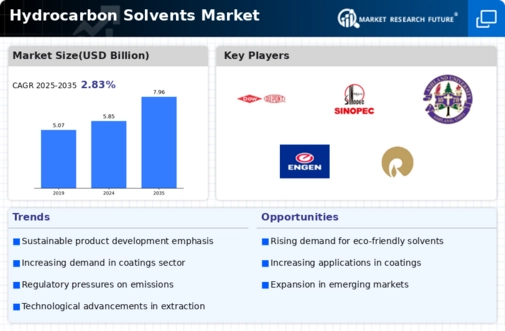Market Trends
Key Emerging Trends in the Hydrocarbon Solvents Market
The market trends of hydrocarbon solvents have been steadily evolving in recent years, driven by various factors including industry demand, regulatory changes, and technological advancements. Hydrocarbon solvents, which include products such as mineral spirits, naphtha, and paraffinic solvents, are widely used in various industries such as paints and coatings, adhesives, cleaning agents, and pharmaceuticals.
The application in industrial cleaning is projected to generate promising future growth in the hydrocarbon solvent market.
One significant trend in the hydrocarbon solvents market is the growing demand for environmentally friendly and sustainable products. With increasing awareness about environmental issues and regulatory pressure to reduce emissions and minimize environmental impact, there has been a shift towards using eco-friendly solvents derived from renewable sources such as bio-based or green solvents. Manufacturers are investing in research and development to develop new formulations and processes to produce hydrocarbon solvents with lower carbon footprints and reduced environmental impact.
Another key trend is the expanding application scope of hydrocarbon solvents. While traditional applications such as paints, coatings, and adhesives continue to be major drivers of demand, there is increasing utilization of hydrocarbon solvents in emerging industries such as pharmaceuticals, personal care products, and agriculture. Hydrocarbon solvents are valued for their versatility, compatibility with a wide range of materials, and ability to dissolve various compounds, making them suitable for diverse applications.
Furthermore, technological advancements are driving innovation in the hydrocarbon solvents market. New extraction techniques, purification methods, and process optimizations are enabling manufacturers to produce solvents with higher purity levels, improved performance characteristics, and enhanced safety profiles. Additionally, the development of novel formulations and specialty grades tailored to specific applications is creating opportunities for differentiation and market growth.
Market consolidation and strategic partnerships are also shaping the landscape of the hydrocarbon solvents industry. Mergers, acquisitions, and alliances among key players are leading to market consolidation, with larger companies seeking to expand their product portfolios, geographic reach, and market presence. These strategic moves enable companies to leverage synergies, enhance operational efficiency, and strengthen their competitive positions in the global market.
Geographically, the demand for hydrocarbon solvents is witnessing significant growth in emerging economies, particularly in Asia-Pacific and Latin America. Rapid industrialization, urbanization, and infrastructure development in these regions are driving increased consumption of solvents for construction, automotive, and manufacturing applications. Moreover, favorable government policies, foreign investments, and rising disposable incomes are fueling market expansion in these regions.
However, the hydrocarbon solvents market also faces challenges and uncertainties. Volatility in crude oil prices, supply chain disruptions, and geopolitical tensions can impact the availability and cost of raw materials, affecting the profitability of solvent manufacturers and pricing dynamics in the market. Additionally, stringent regulations pertaining to solvent emissions, workplace safety, and environmental protection impose compliance requirements and operational constraints on industry participants.









Leave a Comment